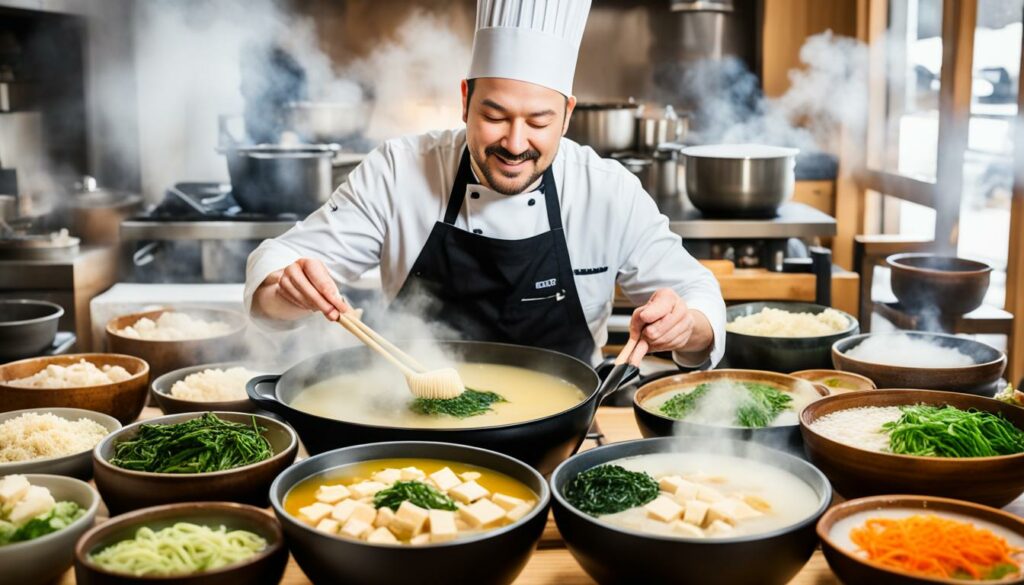Miso paste is a key ingredient in Japanese cooking, loved for its deep savory taste and true Asian flavors. It comes in over 1,300 types, each with its own unique traits. These types are often named after the region in Japan where they come from, showing a long history of cooking1. Miso is a must-have in Japanese kitchens for its many uses and health perks, packed with vitamins, minerals, and protein2. Let’s dive into the world of miso, looking at the different kinds, their health benefits, favorite recipes, and top brands to boost your cooking.
Key Takeaways
- Miso paste is essential for adding umami flavor to dishes.
- There are various types of miso, varying in color and taste.
- Miso offers numerous health benefits including improved digestion.
- It can last for a year or more when stored properly.
- Miso is versatile, used in soups, marinades, and dressings.
Introduction to Miso Paste
Miso paste is a fermented food made from soybeans, grains, salt, and koji. It’s a key ingredient in Asian cooking, with a history of over 1,300 years in Japan34. This seasoning is essential, adding deep, complex flavors to many dishes4.
The making of miso has changed a lot over time. It started in ancient China and came to Japan in the 7th Century3. Fermenting miso not only gives it a unique umami taste but also makes it healthy because of the probiotics it has4.
My own cooking adventures show that miso can really boost the flavor of soups, marinades, or dressings. It brings nutrition and great taste to any meal45.
What is Miso Paste?
Miso paste is a key ingredient in Japanese cooking, made from soybeans, koji (rice bacteria), and salt. It’s known for its ability to boost the taste of many dishes, from soups to marinades. The fermentation process turns miso into a rich, flavorful paste with various levels of saltiness and umami.
For example, red miso is saltier than white or yellow miso, while white miso tastes sweeter and milder67. The fermentation time also varies; white miso ferments for up to two months, while red miso takes 12 to 18 months7.
Miso paste is versatile in the kitchen, used in soups, sauces, glazes, and dressings. It can enhance flavors in many recipes, from light yellow miso in marinades to red miso in hearty dishes78. Not only is miso rich in antioxidants, but it also contains live cultures that support gut health6. You can find miso in refrigerated sections or vacuum-sealed packaging in stores. It should be kept in the fridge to keep its flavor6.
Types of Miso Paste
Miso paste is a key ingredient in many dishes, and knowing the different types can make cooking more fun. Each type has its own unique taste and way of making it. Here are the main types of miso paste I use often.
Shiro (White) Miso
Shiro miso is known for its light color and shorter fermentation time. This gives it a light, sweet flavor and less sodium. It’s great for making salad dressings and soups. It’s a good choice for those new to using miso paste.
Aka (Red) Miso
Aka miso is fermented the longest, giving it a deep, salty taste. It’s perfect for hearty dishes like stews and braises. Chefs love it for its bold flavor, which can make many recipes better9.
Mugi (Barley) Miso
Mugi miso is made with barley and has a flavor between white and red miso. It’s stronger than shiro miso but works well in sauces and marinades. Its versatility makes it a favorite in southern Japan.
Mame (Soybean) Miso
Mame miso is all soybeans and has a strong, pungent taste. It’s great for soups and glazes. Using miso paste well means trying out mame miso for richer flavors.
Arare and Other Varieties
Arare miso is less common but has unique tastes worth trying. With over 1,300 types of miso paste, each one brings something special to dishes. This shows how creative you can be with miso paste in the kitchen10.
Miso Paste is a Staple in Japanese Cooking
Miso paste is key in miso paste in Japanese cuisine. It adds rich, authentic Asian flavors to traditional meals. With over 1,000 types, each with its own taste, from sweet white miso to strong red miso11, it’s vital for many dishes. These varieties enhance textures and balance flavors.
Miso is made from soybeans, salt, and koji and is fermented. This makes it a versatile ingredient. It’s not just for miso soup; it’s great in marinades and dressings too11. Using miso shows Japan’s focus on balance, making food tasty and healthy.
Adding miso to my cooking lets me taste the essence of Japanese food. It’s about making food that’s both delicious and good for you.
| Type of Miso | Primary Ingredients | Flavor Profile | Common Uses |
|---|---|---|---|
| Shiro (White) Miso | Koji from rice, soybeans | Sweet, mild | Soups, dressings |
| Aka (Red) Miso | Koji from barley or soybeans | Rich, savory | Marinades, stews |
| Mugi (Barley) Miso | Barley, soybeans | Earthy, slightly sweet | Soups, sauces |
| Mame (Soybean) Miso | Whole soybeans | Strong, salty | Broths, marinades |
| Arare and Others | Varied grains | Unique, region-specific | Florentine stews, assorted dishes |
Miso’s versatility makes it a key ingredient in Japanese cooking. It shows why miso in traditional dishes is important for real Asian flavors.
Health Benefits of Miso Paste
Miso paste is more than just a tasty addition to my meals. It’s packed with health benefits that boost my well-being. The fermentation process creates probiotics, which are great for my digestive health.
Digestive Health
The probiotics in miso can help my gut microbiome. This might reduce inflammation and make digestion smoother12. Eating fermented soy products like miso regularly supports gut health by encouraging good bacteria13. So, I get to enjoy great flavor and better digestion.
Nutritional Value
Miso isn’t just tasty; it’s also low in calories but high in protein, vitamins, and minerals. It’s packed with manganese and Vitamin K, which are key for muscle health and blood circulation14. Just one tablespoon of miso has about 30 calories and lots of nutrients, making it a great choice for cooking with fresh ingredients13. Miso also has isoflavones that might lower the risk of some cancers, like breast cancer in women after menopause13.
Studies show that eating miso soup daily can help with insulin resistance and blood sugar levels12. This makes miso a smart addition to my diet.
How to Use Miso Paste in Cooking
Miso paste is a versatile ingredient that adds a unique flavor to many dishes. It can make cooking more creative. Learning to use miso in cooking opens up new culinary possibilities.
In Soups and Stews
Miso is great in soups. Its rich, umami taste is perfect for traditional miso soup. It goes well with dashi broth, tofu, and green vegetables.
This mix creates a comforting, flavorful dish. Miso in soups adds nutrition and boosts the meal’s taste.
As a Marinade
Miso can also be used as a marinade. It adds a savory depth to meats and tofu. Mixing miso with sesame oil and other seasonings makes a tasty marinade.
This marinade makes grilled or baked items unforgettable.
In Dressings and Sauces
Miso is also good in dressings and sauces. Blending it with rice vinegar and sesame oil creates a savory dressing. This dressing can be used on salads or as a dipping sauce.
Using miso in dressings and sauces shows its versatility. It can make simple and complex dishes taste new and exciting.

Miso is very adaptable in the kitchen. It can be used in traditional and new recipes. It’s a flavor enhancer and a nutritious addition to any dish151116.
Popular Miso Paste Recipes
Adding miso paste to my cooking has opened up a world of flavors. Miso is versatile, making many delicious dishes. Here are some popular miso paste recipes I recommend.
Traditional Miso Soup
Traditional miso soup is a classic dish that highlights miso’s essence. It uses white miso paste, silken tofu, and wakame seaweed. This soup is comforting and easy to make, taking about 20 minutes in total.
Every sip of this soup is full of rich flavor, earning it a 5-star rating from many17.
Miso-Glazed Fish
This dish makes fresh fish like salmon or cod even better with a savory miso glaze. Just spread miso paste on the fish before grilling or baking. It adds flavor and moisture, making it a healthy choice.
This recipe is a hit at my house for its delicious taste.
Miso in Stir-Fries
Adding miso to stir-fries has changed my quick meals. Miso thickens the sauce and enriches the flavor. Mixing it with fresh ingredients brings out deep, complex flavors easily.
There are many miso paste recipes, like miso marinated chicken and savory miso oatmeal. Each shows how versatile this ingredient is1819.
Cooking with Fresh Ingredients and Miso Paste
Cooking with fresh ingredients and miso paste can turn a simple meal into something special. Using fresh ingredients like bright vegetables, herbs, and spices makes dishes taste better. When I make stir-fries, I mix in flavorful sesame oil and fresh ginger. These add to the rich taste of miso paste.
Stirring in miso at the end of cooking keeps its smell and taste. Boiling miso can reduce its health benefits. I strain miso for soups to avoid lumps20.
Miso is great for dressings because it can be thinned to prevent lumps. When marinating, I remove extra miso to avoid a bitter taste20. This makes my dishes tasty and fun to eat.
Storing miso right is key in my kitchen. Keeping it in a covered container in the fridge keeps it fresh. Miso can last from three weeks to a year, depending on its type21.

Best Miso Paste Brands to Try
Choosing the right miso paste brand can make a big difference in your cooking. Not all miso pastes are the same. Yamabuki Shiro Miso is a top pick for its delicate taste, perfect for subtle recipes22. I also keep white and red miso pastes handy. Red miso, like Shirakiku Miso Aka Soy Bean Paste, is great for hearty dishes and is budget-friendly22.
Local brands like Namikura Shiro Miso offer a healthier option with less salt. Ishino White Miso is another favorite, known for its sweet taste that chefs adore22. Eden Foods Certified Organic Mugi Miso stands out with its unique barley koji flavor, adding a special touch to my recipes22.
My go-to brands include Maruya Hatcho Miso for its earthy taste and Cold Mountain Light Yellow Miso for its sweetness22.
South River Miso Company’s Three Barley Miso is another favorite, aged for a rich flavor. Each brand brings something unique to my cooking.
Exploring different brands and types of miso is key to finding what you like. Aichi is known for its Hatcho miso, while Kyoto is famous for Saikyo miso23. Miso has a long history, dating back to the 900s, and choosing the right brand can take you on a culinary journey23. Trying various top-rated brands will help you discover your favorite flavors.
Conclusion
Miso paste is more than just a key ingredient in Japanese cooking. It connects old traditions with new tastes in the kitchen. This versatile ingredient lets me add deep flavors to many dishes, both classic and new. The miso paste benefits are many, making food taste better and being good for health.
When I cook with miso paste, I find new ways to make my food special. I use it in everything from hearty soups with tofu and seaweed to marinades for fish. Learning about different types of miso, like rice or barley, helps me understand its cultural importance. It also lets me try new recipes at home.
Adding miso paste to my cooking has made my dishes taste better. It has also taught me about its history. As I keep trying new recipes, I plan to always use miso in my cooking. This way, I honor the tradition and benefits of this beloved ingredient in every meal2425.
FAQ
What is miso paste made from?
Miso paste comes from fermented soybeans. It’s often mixed with grains like rice or barley. This mix ferments using a mold called Aspergillus oryzae.
How does miso paste enhance flavor in dishes?
Miso paste brings a deep umami taste to dishes. It’s great in soups, marinades, and dressings. This makes meals more flavorful.
What are the different types of miso paste?
There are five main types of miso paste. These are Shiro (white), Aka (red), Mugi (barley), Mame (soybean), and Arare miso. Each type has its own unique flavor for different dishes.
What are some health benefits of miso paste?
Miso paste is full of probiotics from fermentation. This helps with digestion. It also has protein, vitamins, and minerals for overall health.
How can I use miso paste in my cooking?
Use miso paste in soups and stews for flavor. It’s great as a marinade for meats and tofu. Or add it to dressings and sauces for extra taste.
Can miso paste be included in stir-fries?
Yes, miso paste adds a rich flavor to stir-fries. It enhances vegetables and proteins, making the dish more delicious.
What are some popular recipes that use miso paste?
Popular recipes with miso paste include traditional miso soup and miso-glazed fish like salmon or cod. It also works well in many stir-fry dishes.
How do I choose a good brand of miso paste?
Choose brands like South River Miso, Miso Master, or Yamaki Jozo. Make sure it’s organic and without additives or preservatives for the best quality.
- Growing Bonsai: Tips for Miniature Tree Enthusiasts
- Buying Bonsai: Tips for Selecting Your Perfect Tree
- Bonsai Potting: Essential Tips for Tree Care Success
- Bonsai Maintenance: Essential Care for Tiny Trees
- Mastering the Art of Shaping Bonsai: A Beginner’s Guide
Source Links
- What Is Miso, and How Do I Choose the Right One for What I’m Cooking? – https://www.epicurious.com/ingredients/how-to-buy-store-and-cook-with-miso-paste-recipes-article
- Miso – https://en.wikipedia.org/wiki/Miso
- Origin and history of miso|About Miso | Food Culture | marukome – https://www.marukome.co.jp/global/en/foodculture/aboutmiso/originandhistoryofmiso/
- The Art of Flavour: An Introduction to Miso Paste – https://asianorganics.com.au/asian-recipes/the-art-of-flavour-an-introduction-to-miso-paste/
- Miso Basics: A Japanese miso primer, looking at different types of miso – https://justhungry.com/handbook/just-hungry-reference-handbooks/japanese-miso-primer
- What Is Miso Paste? | Wild Alaskan Company – https://wildalaskancompany.com/blog/what-is-miso-paste?srsltid=AfmBOoq454AEwnFdVNIjQS373wx4h2KP2Z9FVkI2Ak_4VifNNeHWRN1w
- What Is Miso? How To Make and Use Japan’s Magic Paste | Tokyo Weekender – https://www.tokyoweekender.com/food-and-drink/what-is-miso-how-to-make-and-use-japans-magic-paste/
- What Is Miso? A Guide to Japan’s Essential Ingredient – https://www.japanlivingguide.com/dailylife/food/miso/
- 3 Types of Miso (How To Use Them & What They Taste Like) – https://lifebymikeg.com/blogs/all/3-types-of-miso-how-to-use-them-what-they-taste-like
- Ultimate Guide to Different Types of Miso – https://umami-insider.com/blogs/blog/ultimate-guide-to-different-types-of-miso?srsltid=AfmBOoqvK9uuXlj77F8JiYR_tc1BCdYHkMRKWvvzaGfHOpjwe7JAxOsL
- What Is Miso Paste and How Do You Use It? – https://www.cozymeal.com/magazine/miso-paste
- What Is Miso, and Is It Good for You? – https://zoe.com/learn/what-is-miso
- Top 10 health benefits of miso – https://www.bbcgoodfood.com/howto/guide/health-benefits-miso
- What Is Miso? The Health Benefits of Miso and More – U.S. Soy – https://ussoy.org/https-ussoy-org-what-is-miso/
- 5 Rules For Cooking With Miso Paste — Miso Tasty – https://misotasty.com/blog/5-rules-for-cooking-with-miso-paste?srsltid=AfmBOopyfY1quoWcs085s-WBHksj2IPuOqPkQWTCxoga4eDSS0FP5W8O
- What Is Miso Paste: Using Miso for Cooking | KitchenAid – https://www.kitchenaid.com/pinch-of-help/countertop-appliances/what-is-miso.html
- Miso Soup – Love and Lemons – https://www.loveandlemons.com/miso-soup/
- 21 Best Recipes That Start with Miso Paste – https://www.allrecipes.com/gallery/best-recipes-with-miso-paste/
- Making Miso at Home- the Revival of a Once Ubiquitous Late Winter Rite – https://tsukublog.wordpress.com/2023/01/29/making-miso-at-home-the-revival-of-a-once-ubiquitous-late-winter-rite/
- 5 Rules For Cooking With Miso Paste — Miso Tasty – https://misotasty.com/blog/5-rules-for-cooking-with-miso-paste?srsltid=AfmBOopkrGpD4cig0zZxizQrHwu_tJ3QuHxES-lu9-bPRmzM1_M6GBGN
- Homemade Miso Soup (Video) 味噌汁 – https://www.justonecookbook.com/homemade-miso-soup/
- The Best Miso, According to Chefs – https://nymag.com/strategist/article/best-miso-pastes.html
- To Find the Miso You Like Best, Taste It Plain – https://www.bonappetit.com/story/guide-to-miso
- What is Miso Soup, an Essential Part of Japanese Cuisine? – https://media.magical-trip.com/what-is-miso-soup-an-essential-part-of-japanese-cuisine/
- Uncovering Japanese Miso Soup: A Deep-Dive into the History of Miso – https://zendine.co/blog/post/uncovering-japanese-miso-soup-a-deep-dive-into-the-history-of-miso/
- Growing Bonsai: Tips for Miniature Tree Enthusiasts
- Buying Bonsai: Tips for Selecting Your Perfect Tree
- Bonsai Potting: Essential Tips for Tree Care Success
- Bonsai Maintenance: Essential Care for Tiny Trees
- Mastering the Art of Shaping Bonsai: A Beginner’s Guide


